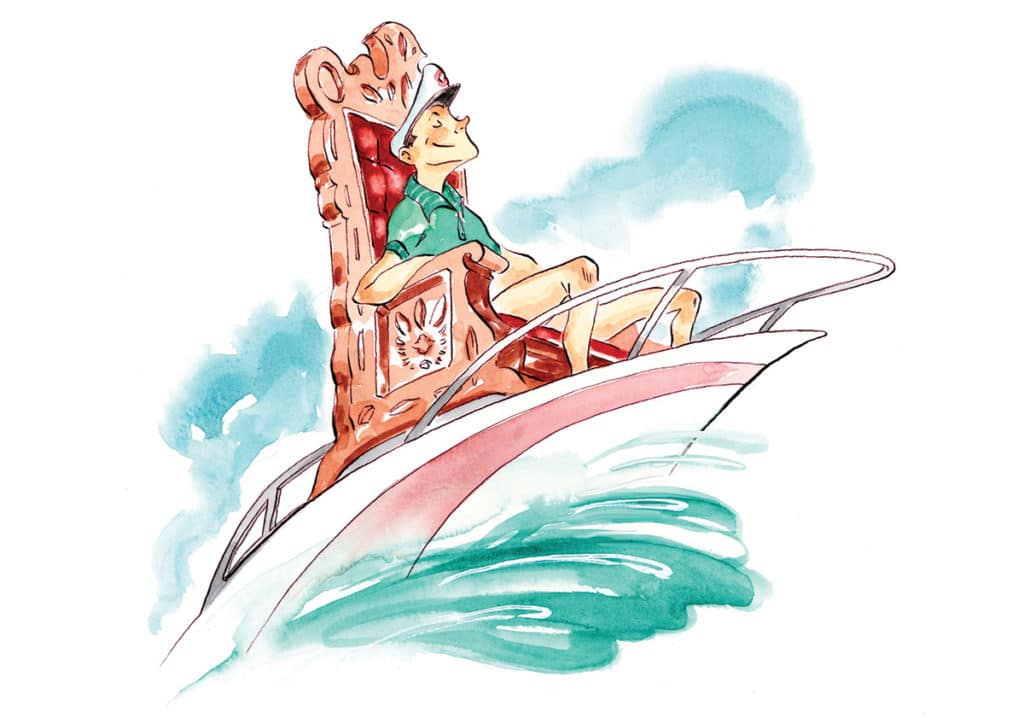
The most common question I get about boating is “how do you go to the bathroom?” OK, it helps to know that my home is New York, where I’m surrounded by city dwellers who see no need to experience life without concrete. Yet, even hard-core boaters ask me the same question because I’ve gone to sea in some odd craft.
I’ve crossed the Bering Strait on a Sea-Doo sealed in a drysuit for 18 hours with this choice: Stay warm or whiz. Call me Frosty. I’ve raced from Miami to New York in an open boat where going to the bathroom meant a cold Atlantic bidet. Call me Frosty the Damp.
Boater or no, we all seem to have this Freudian fascination with toilets. So I wasn’t surprised when I found an academic work about it. Those Vulgar Tubes, by Joe J. Simmons III, is published by Texas A&M, which has the finest nautical archaeology department in the country. This is serious stuff; there’s even a flow chart (historical, not effluvial).
Simmons’ history begins in 600 B.C. with a scene on a Cypriot pitcher of a sailor squatting off the stern and a “fish partaking of this bounty from above.” Yuck. And that’s pretty much the story, less the fish, for the next 2,000 years.
As ships got bigger, with more enclosed decks, another solution was needed. It came in the form of the crew going forward in the beakheads and the officers going aft under the poop decking. Beakheads were originally extended fighting platforms that were refined into a loo by the Spanish in the 1400s. They were the place of choice because ships sailed primarily downwind, so the bow was protected in the lee. There were other contrivances too, essentially seagoing outhouses with colorful names such as steep tubs, sanitary boxes, seats of ease and pissdales, until around 1780, with the introduction of the first internal flushing “head.” And this is where Simmons’ story ends … and our problems begin. Specifically in 1976, the law said we must have a holding tank for inshore cruising.
No seaman likes a hole in his hull, even if it means relief in a warm, dry spot. Yet, crew comfort sometimes comes before safety.
For me, modern marine plumbing has too many hoses, valves and pumps. If it doesn’t sink you, there’s a lot that can go wrong — which will not be pleasant to repair.
That’s why I’m a big fan of the bucket. The best and toughest are black rubber (not plastic) ones used in stables. Check out doversaddlery.com. Fill one-third with seawater and enjoy, but don’t blithely dump the contents. To avoid splash-back, hold the bucket near the water’s surface and quickly invert. Rinse with clean seawater and let dry. It’s cheap, it never fails, and it doesn’t require long explanations to landlubbers on how it’s used. Yes, I know it’s illegal inshore. Have patience and wait until you’re offshore before seeking relief.
Too primitive? Have ladies on board? Then go with a portable toilet. There are almost no moving parts, it works by gravity, it’s idiot-proof, and there is no documented case of one sinking a boat. It saves space and hundreds of dollars over a pumping system. It’s a pain to lug ashore, but some can be connected for pump-out.
On large boats, you’re stuck playing plumber. For the rest of us, consider that our ancestors knew a thing or two about where to poo.
That’s why, when I see you outside the inlet, I’ll probably have gone to the bathroom at the marina.









